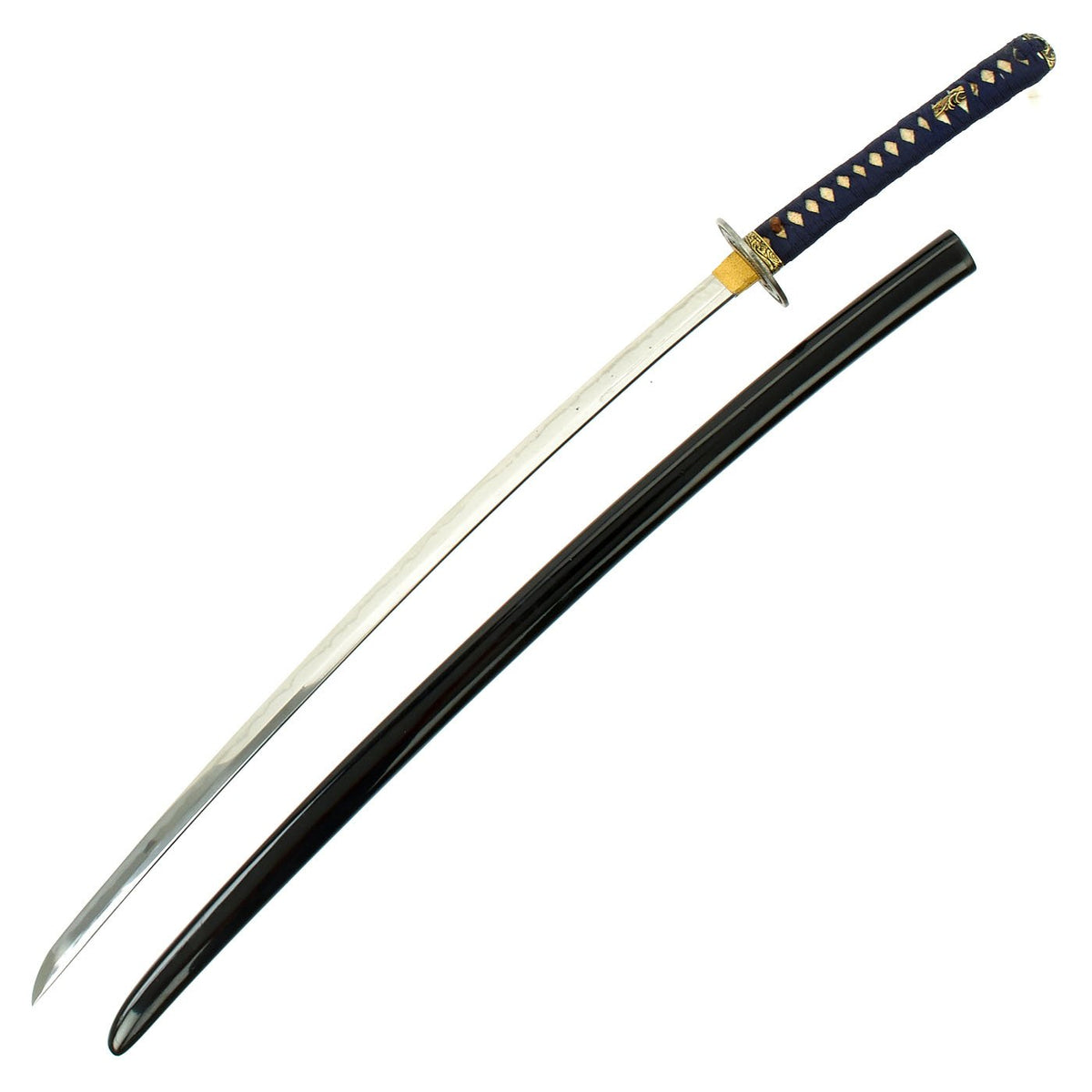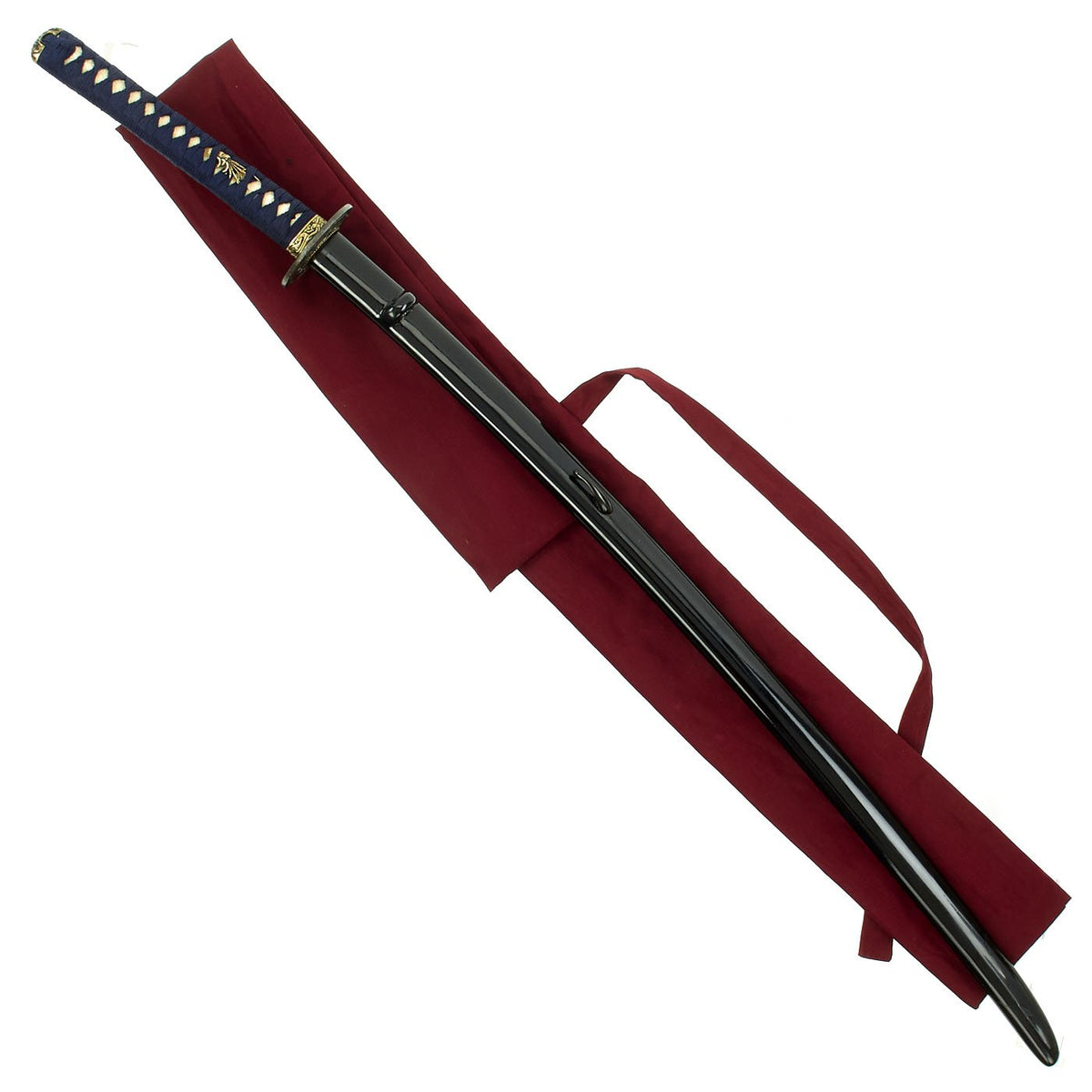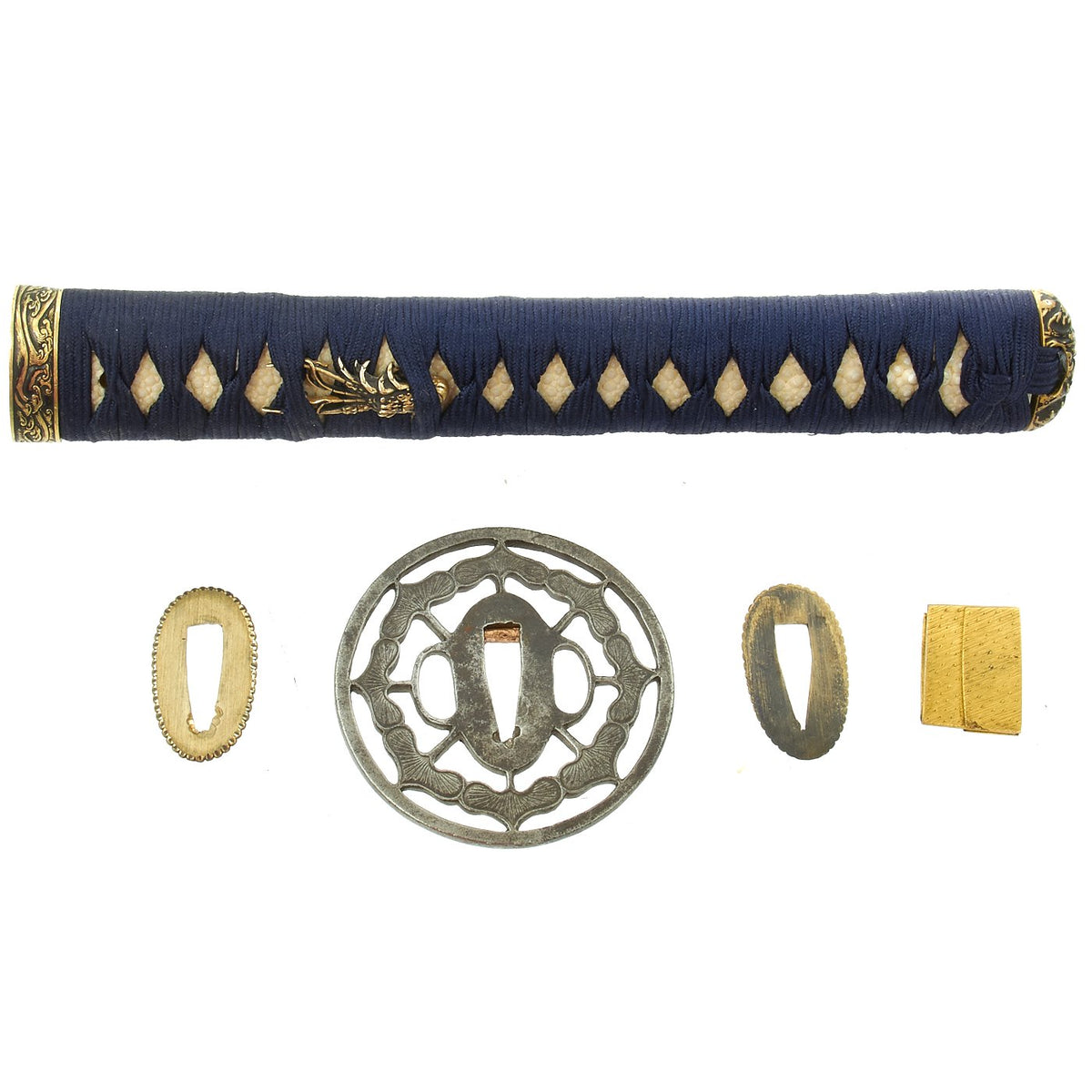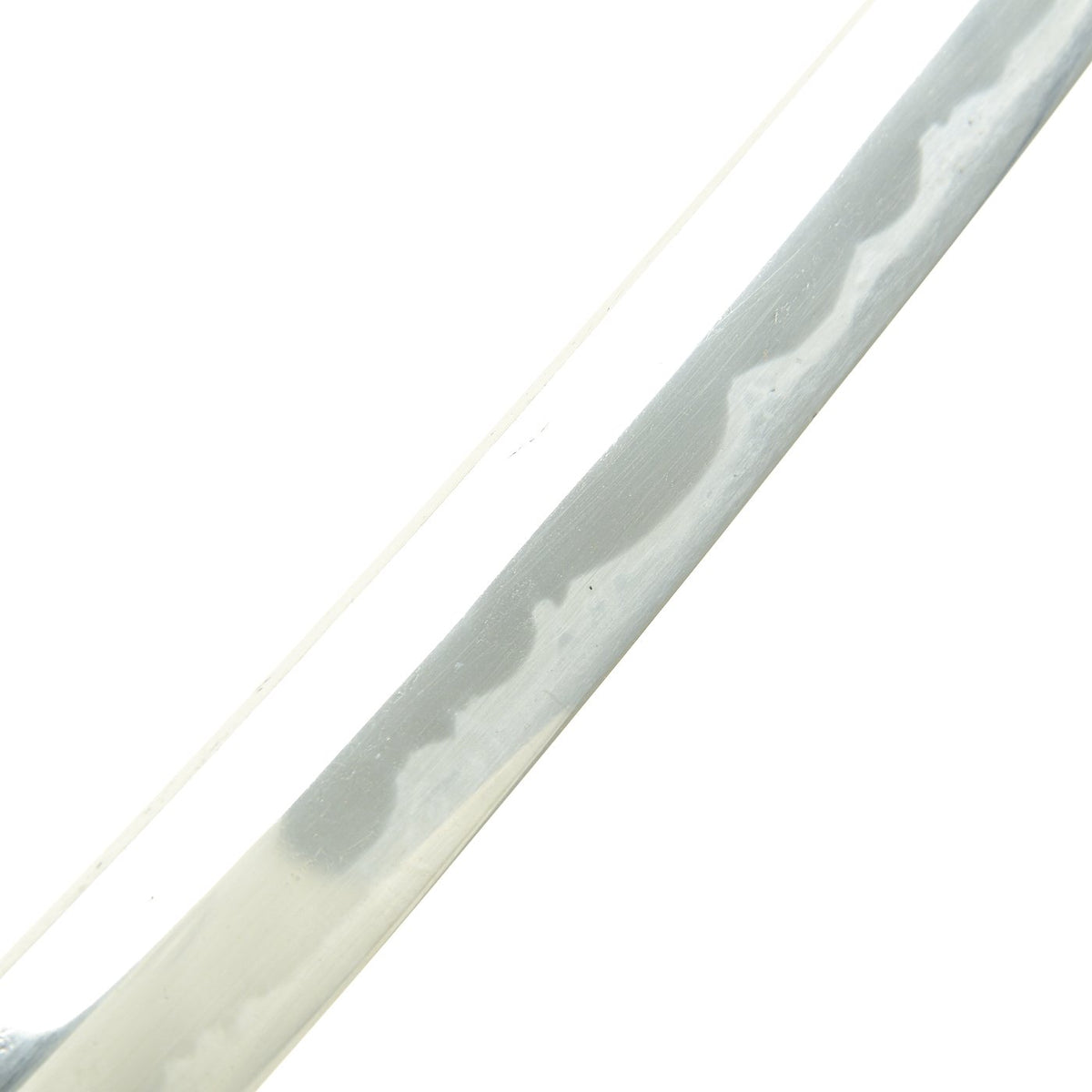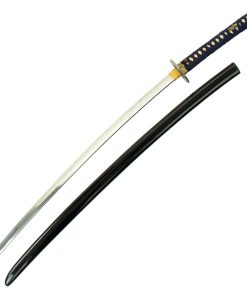Original 16th Century Japanese Katana Samurai Sword with Ancient Handmade Fullered Blade Original Items
$ 13.995,00 $ 3.498,75
Original Item: Only One Available. Purchased directly from a private collection, this is a wonderful condition Japanese Katana, complete with some very nice Koshirae (fittings). It has a very attractive blade with a nice polish, and one of the best temper lines we have ever seen. The blade is also quite lightweight, much more typical of more peaceful times. During wartime, the heavier the blade the better for the most part.
The blade is genuine and ancient, as indicated by a few tell tale characteristics that include:
– Holes in the tang (mekugi-ana) are punched and not drilled. The two holes indicate that the blade has been refit at least once, probably shortening it slightly.
– Tang is shows oxidation and great age. It does not appear to be signed, which is called “mumei”, or nameless. Many highly sought after Japanese swords are unsigned. The collector we purchased it from estimated it was probably from the 16th century, though possibly older. It may have at one time been signed, but oxidation or blade shortening could have removed it.
– Folded steel blade (fold lines are evident on the body and spine of the blade)
– Clear grain (“hada”) in the body of the blade, showing lamination The steel used to make Nihonto (Japanese Swords) is folded over and over before the pieces are laminated together to form the blade. This is what gives the steel “grain”.
– Vibrant visible temper line (“hamon”) with nie and nioi crystralization present along the temper line. It is a truly lovely sight.
– The body of the blade shows blade KIZU, or wounds, which are carbon inclusions and other impurities that arise from the forging process. Only hand forged laminated blades can have these.
Offered in very good condition with a clear temper line, it is still very sharp. Overall length is 38 1/2 inches, with a 27 3/4 inch long blade. The sugata (blade shape) is the standard Shinogi Zukuri. The defining features of this shape are that it has a shinogi (blade flat) closer to the mune (back edge) than the ha (sharp edge), it has sori (curvature), and it has a yokote (dividing line marking the start of the tip or kissaki. The Blade MUNE (spine) is the IHORI (two sided) type. Looking at the overall shape, this blade was once longer, and then was cut down through the process of SURIAGE. It may have at one point had a blade exceeding 30 inches, and the shape indicates it was made as a TACHI, a forerunner of the Katana.
The polish on the blade is excellent, with just a few areas with tiny scuffs, and one small area near the kissaki where it was improperly cleaned. The HAMON (wave) temper line, which is of the TORAN (billowing) type, is just incredible. It’s almost impossible to photograph just how good this presents. The BOSHI (blade end) has a temper line that goes all the way around it, 4 inches onto the spine of the blade. This may be a JIZO type, which is said to look like Buddha’s head. This is the hallmark of a well-forged blade. The blade is also somewhat light, due to two BO’HI, or fullers, which extend down the blade flats. Interestingly, the left side fuller extends half way down the blade, while the right is only about 5 inches long. These do not extend far past the HA-MACHI, so they were probably not originally on the blade when it was longer.
There are some blade wounds (kizu), which are caused by small carbon and air pockets in the steel from when it was originally folded. These are normal and confirm the authenticity, as without lamination, there is no possibility for these artifacts. The blade has a standard Futsu shaped NAKAGO (tang) with KIRI straight cut NAKAGO-JIRI (tang tip). This blade has been shortened through SURIAGE PROCESS, as that is the only time that a KIRI tip is seen. Two mounting holes are present, though only one is in use.
The TSUKA (handle) features a nice round TSUBA (cross guard) with MENUKI (grip decoration), and a nice KASHIRA (End Cap). All of these are decorated with lovely designs, and brass and copper inlay. The tsuba is iron, while the fuchi (grip collar) and end cap are blacked brass. The handle also has an excellent stingray (Sa-Me) grip with complete Ito (cloth binding). The TSUBA is much older than the other KOSHIRAE (fittings), which look to be relatively recent professional replacements. It’s very normal for fittings to be replaced once they have worn out, and unfortunately there is often no way to restore them.
The Scabbard (saya) is wood, with a beautiful gloss black lacquer finish. It has a few small dents, but is highly attractive and definitely top quality. It has a nice kurikata (knob) on the scabbard. This is where a sageo (sword cord) would be inserted to secure the saya to the obi when in traditional Japanese dress.
We do not get many blades of this age in, and this would make a worthy addition to any sword collection.
It has been over one thousand years that the art of making swords appeared in Japan. The swordsmiths of the time may not have known it but they were creating a legendary sword. The Samurai sword has seen combat in many battlefields. From the early days of the Samurai warrior to the fierce battles in the South Pacific during WWII.
Each hand-made Samurai sword is unique because it is forged from multiple pieces of folded steel stock, which are then laminated together. A tremendous amount of work is dedicated to creating these pieces. They were an instrument of war as much as a beautiful artifact to adorn a room. They were also relatively expensive, and would be passed down in the family for generations, until the blade was too worn to be polished and put in a new setting.
The Samurai sword has grown to be one of the most highly desired military antiques.
Fast Shipping with Professional Packaging
Thanks to our longstanding association with UPS FedEx DHL, and other major international carriers, we are able to provide a range of shipping options. Our warehouse staff is expertly trained and will wrap your products according to our exact and precise specifications. Prior to shipping, your goods will be thoroughly examined and securely secured. We ship to thousands clients each day across multiple countries. This shows how we're dedicated to be the largest retailer on the internet. Warehouses and distribution centres can be located throughout Europe as well as the USA.
Note: Orders with more than one item will be assigned a processing date depending on the item.
Before shipping before shipping, we'll conduct a thorough inspection of the items you have ordered. Today, the majority of orders will be delivered within 48 hours. The delivery time will be between 3-7 days.
Returns
The stock is dynamic and we cannot completely manage it because multiple stakeholders are involved, including our factory and warehouse. So the actual stock may alter at any time. It's possible that you may not receive your order once the order has been made.
Our policy is valid for a period of 30 days. If you don't receive the product within 30 days, we are not able to issue a refund or an exchange.
You can only return an item if it is unused and in the same state as the day you received it. You must have the item in its original packaging.
Related products
Uncategorized
Armoured Fighting Vehicles of the World: AFVs of World War One (Hardcover Book) New Made Items
Uncategorized
Uncategorized
Uncategorized
Uncategorized
Uncategorized
Band of Brothers ORIGINAL GERMAN WWII Le. F.H. 18 10.5cm ARTILLERY PIECE Original Items
Uncategorized
Uncategorized
Uncategorized
Australian WWII Owen MK1 Machine Carbine SMG Custom Fabricated Replica with Sling Original Items
Uncategorized
Uncategorized
Armored Burgonet Helmet & Polearm from Scottish Castle Leith Hall Circa 1700 Original Items
Uncategorized
Uncategorized
Uncategorized
Uncategorized
Uncategorized
Uncategorized
Uncategorized
